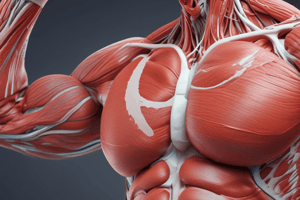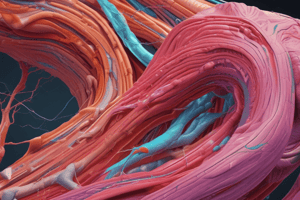Podcast
Questions and Answers
What is the primary function of skeletal muscle tissue?
What is the primary function of skeletal muscle tissue?
- Voluntary control (correct)
- Contracting the bladder
- Involuntary control
- Organized contraction
Where is cardiac muscle tissue primarily located?
Where is cardiac muscle tissue primarily located?
- Arteries and veins
- Bladder
- Digestive system
- Heart (correct)
What is the unique feature of smooth muscle tissue?
What is the unique feature of smooth muscle tissue?
- Involuntary control (correct)
- Voluntary control
- Multinucleated
- Striated fibers
How do skeletal muscles primarily contract?
How do skeletal muscles primarily contract?
Which type of muscle tissue has branched and striated fibers?
Which type of muscle tissue has branched and striated fibers?
What regulates the binding and detachment of myosin heads from actin during muscle contraction?
What regulates the binding and detachment of myosin heads from actin during muscle contraction?
What is the structure of muscle fibers in terms of their ability to stretch, retract, and contract?
What is the structure of muscle fibers in terms of their ability to stretch, retract, and contract?
Study Notes
- Muscles are a magnificent part of the muscular system, consisting of various types of muscle tissue.
- Muscle tissue is made up of muscle fibers, which have a striped structure and can stretch, retract, have excitability, and contract.
- There are three types of muscle tissue: cardiac, smooth, and skeletal.
- Cardiac muscle tissue, located in the heart, has branched and striated fibers, intercalated discs for organized contraction, and involuntary control.
- Smooth muscle tissue, found in the digestive system, arteries and veins, bladder, and eyes, is spindle-shaped, involuntary, and involved in various functions.
- Skeletal muscle tissue is striated, multinucleated, and attached to bones or skin, allowing for voluntary control.
- Skeletal muscles are named based on their location or shape, and can be identified by diagrams.
- Skeletal muscles contract by the sliding-filament model, where actin thin filaments slide past myosin thick filaments due to the myosin heads' power strokes.
- The myosin heads' binding and detachment from actin are regulated by calcium ions and regulatory proteins, allowing for muscle contraction and relaxation.
Studying That Suits You
Use AI to generate personalized quizzes and flashcards to suit your learning preferences.
Description
Test your knowledge of the muscular system and different types of muscle tissue such as cardiac, smooth, and skeletal. Learn about the structure and functions of muscle fibers, as well as the mechanisms of muscle contraction and relaxation.




